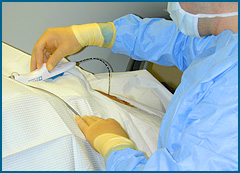 Fine-needle aspiration is the name of the process of obtaining a sample of cells and bits of tissue for examination by applying suction through a thin, hollow needle attached to a syringe. The sample of cells and bits of tissue is called a biopsy.
Fine-needle aspiration is the name of the process of obtaining a sample of cells and bits of tissue for examination by applying suction through a thin, hollow needle attached to a syringe. The sample of cells and bits of tissue is called a biopsy.
Needle biopsies can be obtained through the chest wall into the lung. Lesions (abnormalities) that can be evaluated in this way are those that are large enough and on the outside of the lung. Not every lung lesion can be accessed with a needle.
The skin is cleaned and numbed with anesthesia called lidocaine that causes loss of sensation to prevent pain. The needle is placed under radiologic imaging (usually fluoroscopy or CT scanning) to help guide the needle into the lesion. There should be minimal pain during the procedure, as most of the pain fibers can be numbed with anesthesia. Some patients cough up some blood, but this is uncommon and the amount of bleeding is usually very small.
Since the needle is puncturing the lung, the lung may collapse. The likelihood of lung collapse depends on how big the lesion is, the amount of emphysema (abnormal increase in the size of air spaces in the lung) near the lesion, and how deep the lesion is from the chest wall. Many patients with a lung collapse have only some mild chest discomfort and mild shortness of breath; if so, there is no treatment necessary.
If the lung collapses further, a small tube may need to be inserted to re-expand the lung until the hole stops leaking. If a tube is placed, you may require admission into the hospital for 1-2 days. The physician doing the biopsy will explain this to you prior to the procedure. Because of the risk of lung collapse, you will have x-rays performed after the biopsy and may require observation in the hospital for 3-4 hours after the biopsy.
Results of a biopsy may take 2-4 days to be available. The yield of needle biopsy is usually very high, but a negative result does not prove that you don't have cancer. There is always the chance of a "false-negative" result-a test result that is erroneously classified in a negative category because of imperfect testing methods or procedures.
Please click here for instructions.


